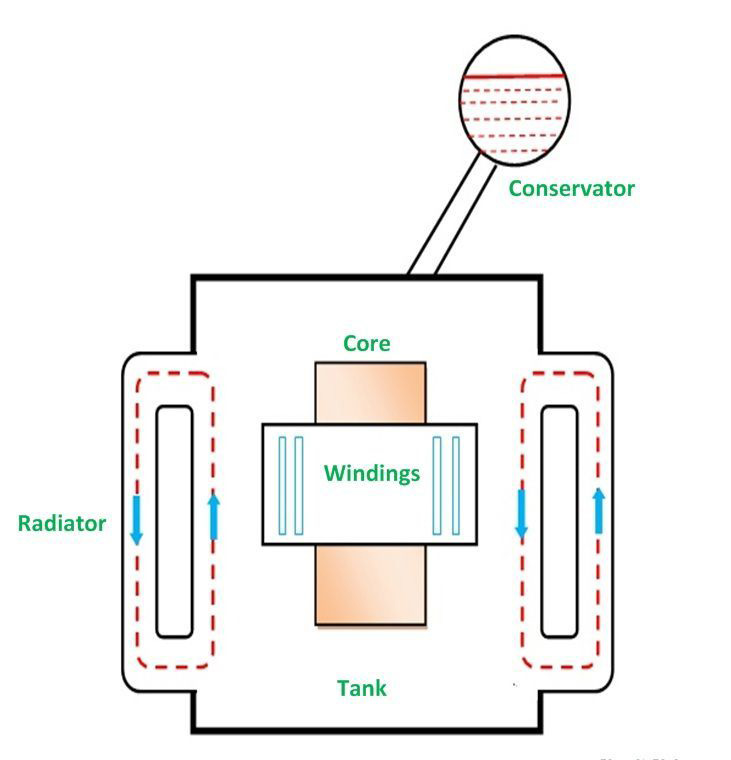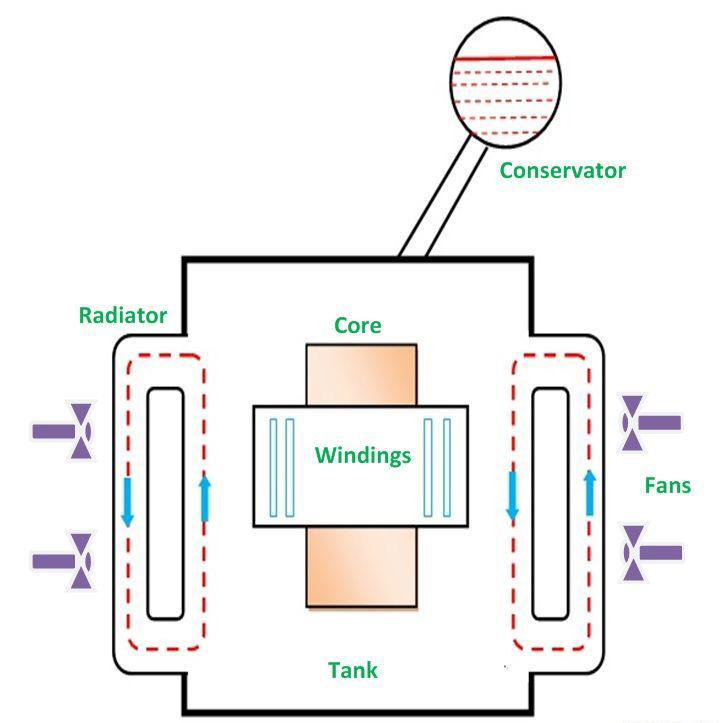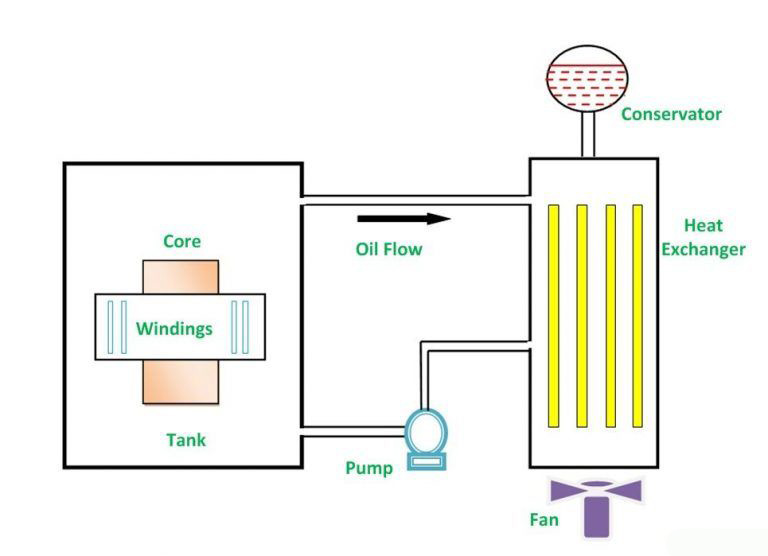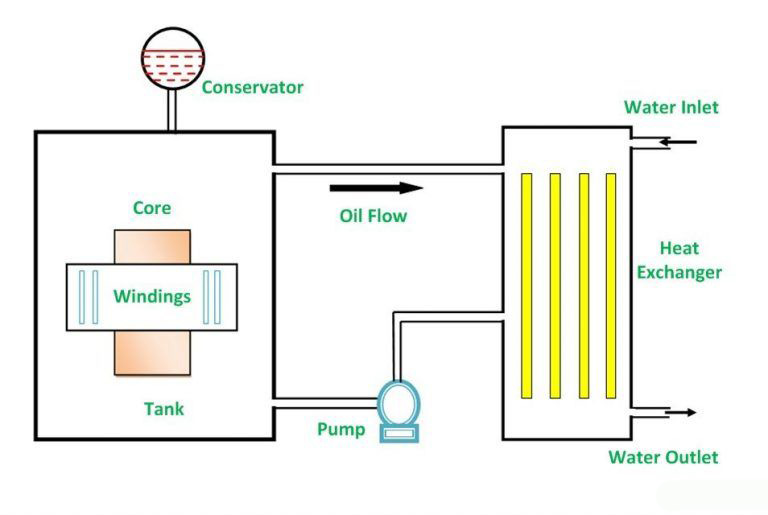Dry Type Transformer is cooled by the following two methods given below:
By Air Natural method the generated heat in the transformer is cooled by the circulation of natural air. When the temperature of the transformer becomes higher as compared to the temperature of the surrounding air, thus by the process of natural convection, heated air is replaced by the cool air. This method is also known as a self-cooled method.
In this method, the heat generated is cooled by the forced air circulation method. With the help of fans and blowers, high velocity of air is forced on the core and the windings of the transformer. As the temperature inside the transformer goes beyond the standard safe level, an alarm is activated, and the fans and blowers are switched ON automatically.
Oil-immersed power transformer cooling mode, according to the size of its capacity, the cooling system can be divided into: oil-immersed self-cooling, oil-immersed air cooling, forced oil circulation air cooling, forced oil circulation water cooling and so on.
1,Oil Natural Air Natural (ONAN)
The oil-immersed self-cooling cooling system has no special cooling equipment. The oil circulates naturally in the transformer, and the heat from the iron core and winding is transmitted to the tank wall or radiator by the convection of the oil. According to the size of transformer capacity, it can be divided into three different structures
1.1. Smooth box wall. The transformer with small capacity adopts this structure, the box shell is welded with steel plate, and the box wall is completely smooth;
1.2. Heat dissipation ribbed box wall. Some heat dissipation bars are welded on the smooth box wall to expand the area of contact with air, which is suitable for transformers with slightly larger capacity;
1.3. Dissipating heat pipe or radiator cooling. For transformers with larger capacity, in order to increase the cooling surface of the tank, a number of radiators are installed outside the tank. The radiator is a group of heat dissipating tubes with upper and lower coupling boxes. The radiator is connected with the tank through a flange and is a removable part.
FIG. 1 shows the oil flow path of an oil-immersed self-cooling transformer with a radiator tube. When the transformer is running, the oil in the oil tank is heated by the heating of the iron core and winding, and the hot oil rises to the top of the oil tank, and then enters the heat pipe from the upper entrance of the heat pipe. The outer surface of the heat pipe is in contact with the cold air outside, so that the oil is cooled. The cold oil drops in the radiator tube and flows into the lower part of the transformer tank from the lower end of the tube, which automatically circulates the oil flow and effectively cools the transformer core and winding.
The oil-immersed self-cooling system has the advantages of simple structure and high reliability, and is widely used in transformers with capacity below 10,000 kVA.

2. Oil Natural Air Forced (ONAF)
oil-immersed air-cooled cooling system, also known as oil natural circulation and forced air-cooled cooling system. It is installed in the transformer tank next to the radiator of one to several fans, the natural convection of air change to forced convection, in order to enhance the heat dissipation capacity of the radiator. Compared with the self-cooling system, the cooling effect can be increased by 150% ~ 200%, equivalent to the transformer output capacity increased by 20% ~ 40%.
When the load is low, the fan can be stopped to enable the transformer to operate in self-cooling mode. When the load exceeds a specified value, such as 70% of the rated load, the fan can be automatically put into operation. This cooling method is widely used in medium capacity transformers above 10,000 kVA.
3, Oil Forced Air Forced (OFAF)
forced oil circulation air cooling system for large capacity transformers. This cooling system is based on oil-immersed air-cooled type, with submersible oil pump on the connecting pipe between the main tank housing and the radiator with fan (also called cooler). When the oil pump runs, the oil in the forced oil tank is sucked into the radiator from the upper part, and then enters the oil tank from the lower part of the transformer to realize the forced oil circulation. The effect of cooling is related to the rate of oil circulation. FIG. 2 shows the cooling structure of a forced oil circulation air-cooled cooling system used in a large transformer.
4. Oil Forced Water Forced (OFWF)
Forced oil circulating water cooling system is composed of submersible oil pump, oil cooler, oil pipe, cooling water pipe and so on. When working, the oil on the upper part of the transformer is pumped by the oil pump and pressurized. When the oil is forced through the oil cooler, the cooling water is used to cool the oil. Therefore, in this cooling system, the heat of the iron core and winding is first transferred to the oil, and the heat in the oil is then transferred to the cooling water. This cooling effect is very good, but the sealing requirements of the transformer are very high, and the oil pressure in the cooling process must be higher than the pressure of the cooling water.